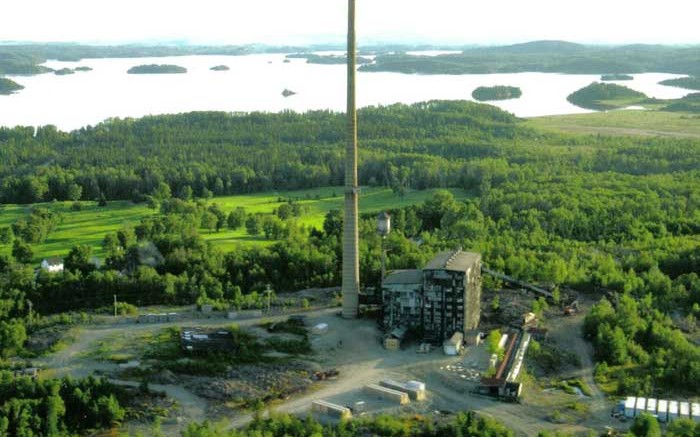VANCOUVER — Clifton Star Resources (TSXV: CFO; US-OTC: CFMSF) could turn its Duparquet project in Quebec into an open-pit gold mine for $394 million, according to a new prefeasibility study.
However, extracting gold from the refractory mineralization at Duparquet would cost US$1,042 per oz., which means the mine’s returns would be tight at today’s gold price.
Duparquet is in northwest Quebec, 50 km by road north of Rouyn-Noranda. Clifton Star has sketched out a plan for a 10,000-tonne-per-day open-pit mine at the property, which is home to two historic mines that produced 1.3 million oz. gold in the 1930s.
The new plan for Duparquet would see the mine churn out 1.7 million oz. over an 11-year mine life at an average 158,000 oz. a year. The ounces would come from proven and probable reserves totalling 39.4 million tonnes grading 1.5 grams gold per tonne. Most of those tonnes are in the ground, though the count also includes 4 million tonnes of historic tailings.
The ounces in the ground are not easily accessed: the operation carries a life-of-mine strip ratio of 8.26 to 1, or 8.92 to 1, when overburden removal is taken into account. Gold recovery is high, averaging 90.1%, but it comes at a cost.
With the mineralization at Duparquet being refractory, cyanide is ineffective in recovering gold because the rock contains substances that either consume the cyanide before it can dissolve the gold, preferentially adsorb the gold as it dissolves or completely surround the gold particles, and block cyanide’s access.
There are ways to recover refractory gold, but they are more complicated than cyanidation. Roasting releases the precious metal by oxidizing the sulphur and organic carbon, bio-oxidation uses bacteria to oxidize the minerals, pressure oxidation removes sulphur in a continuous autoclave at high pressures, and ultra-fine grinding liberates gold particles when the matrix is the main concern.
At Duparquet, Clifton Star plans to use pressure oxidation and leach the gold from the oxidized material.
“Ore” would be crushed, ground and floated. The flotation concentrate would undergo pressure oxidation, which produces gold attached to a carbon pulp. Carbon stripping would isolate the gold and an electrowinning process would refine it.
The company also considered ultra-fine grinding for Duparquet, which testing showed would produce a concentrate grading 50 grams gold, 50 grams silver per tonne and 31.4% suphur that would be sold to smelters for processing. But the extra costs associated with bagging, shipping and smelting — along with the lower payables for gold and silver — meant concentrate production would be less economic than pressure oxidation.
The pressure oxidation process would produce two kinds of tailings. Most of the tailings — 94% — would contain very little sulphide and arsenic and no cyanide, and be stored in a conventional thickened tailings pond. A lined impoundment would be built for the other 6% of tailings, which would come from the autoclave circuit and contain cyanide.
Before any mine is built, Clifton Star would have to address legacy issues at the property. An old roaster, used to recover gold from Duparquet’s refractory ore in the 1930s, still needs to be demolished. A historic tailing dump has to be isolated from a lake and reclaimed, and water runoff from the area should be collected, controlled and treated.
Capital costs for the environmental pre-construction work would total $53.1 million.
This amount is included in the $394-million capital-cost estimate for Duparquet. For that investment Clifton Star could produce an ounce of gold at an all-in cost of US$1,042.
Using a US$1,300 per oz. gold price and a 5% discount rate, the study gives Duparquet an after-tax net present value of $135 million. The mine would generate a 12.1% after-tax internal rate of return, enabling capital payback in 4.3 years.
The preliminary economic analysis of Duparquet that Clifton Star released in early 2013 offered better economics, but it relied on a US$1,472 per oz. gold price.
Clifton Star sees potential to extend the Duparquet mine life by upgrading more resources to reserve status. The project has 23.7 million measured and indicated tonnes grading 1.48 grams gold, plus 29.6 million inferred tonnes averaging 1.5 grams gold of resources that are not included in the reserve count. Clifton Star has received results from another 47 holes after the resource calculation cut-off date, including the best result from the project to date: 34 metres of 5.64 grams gold.
The deposit remains open along strike and at depth. The project’s closeness to the town of Duparquet also led Clifton Star to design a mine plan that leaves parts of the deposit in the ground so that it can minimize impacts on the town and provincial infrastructure.
Clifton Star has not started the permitting process for Duparquet. The company estimates that permitting and construction would take four years.
The company’s share price stayed at 30¢ after the news. This is near the midpoint of the company’s 52-week range, which runs from 15.5¢ to 55¢. Clifton Star has 38.7 million shares outstanding, with $2.9 million in the bank since the beginning of 2014.


This article fails to mention that Clifton Star only owns 10% of the Duparquet project, and is required to pay the owner of the project over $50M over the next few years to exercise its option on the remaining 90%.
One would think that’s a key point considering the company has a $3.4M in cash, a 31 cent share price and less than $12M in market cap.
Guess what happens if they don’t make the $50M payment…